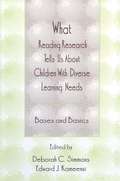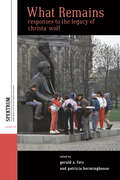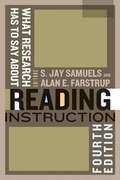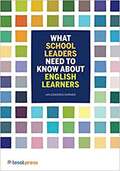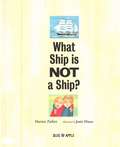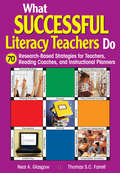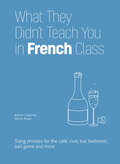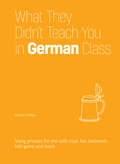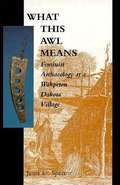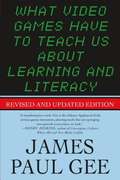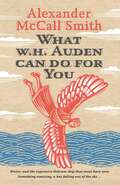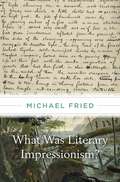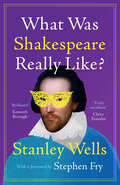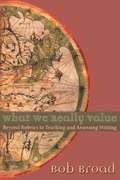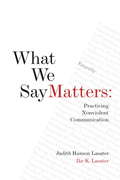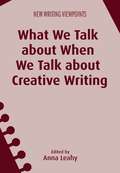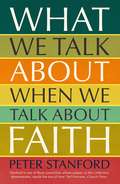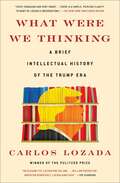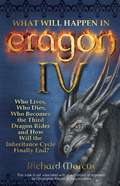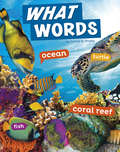- Table View
- List View
What Reading Research Tells Us About Children With Diverse Learning Needs: Bases and Basics (The LEA Series on Special Education and Disability)
by Edward J. Kameenui Deborah C. SimmonsThe purpose of this book is to communicate findings of a research synthesis investigating the bases of reading failure and the curricular and instructional basics to help guide the design and advancement of children's reading performance. The synthesis--completed by the National Center to Improve the Tools of Educators (NCITE) and sponsored by the U.S. Department of Education's Office of Special Education Programs--was conducted as part of NCITE's mission to improve the quality of educational tools that largely shape practice in American schools.
What Remains: Responses to the Legacy of Christa Wolf (Spektrum: Publications of the German Studies Association #24)
by Patricia Herminghouse Gerald A. FetzArguably the most important—and influential—German woman writer of the last century, Christa Wolf was long heralded as "die gesamtdeutsche Autorin," an author for all of Germany; but, after 1989 in unified Germany, Wolf found herself suddenly embroiled in controversies that challenged her integrity and consigned her to an ideologically suspect identity as "DDR Schriftstellerin” (GDR writer) or “Staatsdichterin” (state poet). What Remains: Responses to the Legacy of Christa Wolf asks the question of what truly remains of her legacy in the annals of contemporary German culture and history. Unlike most of what appeared in the wake of Wolf’s death, however, the contributions to this international volume seek neither to monumentalize her nor to dismantle her stature, but to employ a range of methodologies—comparative, intertextual, psychoanalytic, historical, transcultural—to offer sensitive assessments of Wolf’s major literary texts, as well as of her lesser known work in genres such as film and essay.
What Research Has to Say About Reading Instruction 4th Edition
by S. Jay Samuels Alan E. FarstrupChapters such as ''Implementing a Response to Intervention Model to Improve Reading Outcomes for All Students,'' ''Integrating Reading Strategies and Knowledge Building in Adolescent Literacy Instruction,'' and ''Reading Engagement Among African American and European American Students'' reflect changes and current thinking in the field. Others focus on core and timeless elements of reading instruction, such as word recognition, fluency, and comprehension.
What School Leaders Need to Know About English Learners
by Jan DormerSchool leaders have the unique opportunity and responsibility to play a crucial role in creating a culture of high expectations and an environment of support so that English language learners can succeed and continue to enrich the fabric of our country. <p><p> What School Leaders Need to Know About English Learners offers school leaders the foundation, the ideas, and the strategies to not only improve outcomes for English language learners, but to create rich multicultural and multilingual school environments which benefit all students. This book equips school leaders with effective, research-based strategies and best practices to help both ESOL and content-area teachers succeed in their roles. Includes a Professional Development Guide and a rich array of "Grab and Go" online resources. Copublished with National Association of Secondary School Principals (NASSP).
What Ship Is Not a Ship
by Harriet ZiefertWhat language lesson doesn't seem like a lesson? The fun guessing game inside this book! Clever word groupings list three things that are alike and one that it is different. For example, there are living rooms, bedrooms, and bathrooms, but a mushroom is not a room! Picture clues will help kids figure out which thing is different and begin to grasp fine-tuned nuances of word parts, roots, and meanings. In addition, the text's guessing-game approach invites kids into a call-and-response dynamic. This title is a great companion to the well-received Do You Know Which Ones Will Grow? and What Is Part This, Part That?
What Successful Literacy Teachers Do: 70 Research-Based Strategies for Teachers, Reading Coaches, and Instructional Planners
by Neal A. Glasgow Thomas S. FarrellPresents easy-to-implement literacy strategies covering phonics, phonemics, and decoding; vocabulary, spelling, and word study; fluency, comprehension, and assessment; and technology, special learners, and family literacy.
What They Didn't Teach You in French Class: Slang Phrases for the Café, Club, Bar, Bedroom, Ball Game and More (Dirty Everyday Slang)
by Henry Rowe Adrien ClautrierDrop the textbook formality and chat with the locals in France’s everyday language—from common words for meeting and greeting to colorful insults. Sipping a café au lait at a sidewalk bistro . . . Getting down at Paris’s hottest club . . . Cheering on Les Bleus at the stadium . . . Packed with slang words, phrases and expressions not found in any textbook, this fun-to-read handbook teaches the casual, everyday language heard in the cafes, bars, and streets of France. No one actually speaks the formal French taught in school, which makes this book a must-have for anyone looking to chat with the locals without sounding like a robot. This handy phrasebook is perfect for travelers and students who want to fill the gap between the French they are learning in class and what is really spoken in France.What’s up? Ça va?She’s totally hot. Elle est bandante.This party is lit! Cette bringue est enflammée!That brie smells funky. Ce brie sent putain de drôle.Wanna French kiss? On se roule une pelle?That ref is a moron. L’arbitre est un abruti.
What They Didn't Teach You in German Class: Slang Phrases for the Café, Club, Bar, Bedroom, Ball Game and More (Dirty Everyday Slang)
by Daniel ChaffeyThe down and dirty phrases you need to speak German like a local—from tech speak to talking smack with fellow sports fans.Drinking a Hefeweizen at a Biergarten . . . Dancing at Berlin’s hottest club . . . Cheering for the local soccer team at the Stadion . . . Ditch the textbook dialogues and learn to really engage in meaningful (and sometimes meaningless) conversations with lifelong German speakers. From getting a date to hailing an Uber driver, you’ll learn helpful phrases and info to break down the language and cultural barrier. What’s up? Wie geht’s?He/She is a real hottie. Er/Sie ist eine ganz heiße Nummer.What’s on tap? Was gibt’s vom Fass?I ordered the Currywurst. Ich bin den Currywurst.Do you wanna cuddle? Willst Du kuscheln?Gooooooal! Toooooor!
What They Saw in America
by James L. Nolan Jr.Grounded in the stories of their actual visits, What They Saw in America takes the reader through the journeys of four distinguished, yet very different foreign visitors - Alexis de Tocqueville, Max Weber, G. K. Chesterton and Sayyid Qutb - who traveled to the United States between 1830 and 1950. The comparative insights of these important outside observers (from both European and Middle Eastern countries) encourage sober reflection on a number of features of American culture that have persisted over time - individualism and conformism, the unique relationship between religion and capitalism, indifference toward nature, voluntarism, attitudes toward race, and imperialistic tendencies. Listening to these travelers' views, both the ambivalent and even the more unequivocal, can help Americans better understand themselves, more fully empathize with the values of other cultures, and more deeply comprehend how the United States is perceived from the outside.
What This Awl Means: Feminist Archaeology at a Wahpeton Dakota Village
by Janet D. SpectorWhat This Awl Means is the first book to show how feminist criticism and methods can be brought to the practice and writing of archaeology. Focusing on Little Rapids, a 19th-century Eastern Dakota (Sioux) planting village near present-day Minneapolis, the author brings together information from archaeological, documentary, oral, and pictorial sources to highlight the activities and accomplishments of Dakota women and to show the significance of gender in shaping history.
What Video Games Have to Teach Us about Learning and Literacy
by James Paul GeeJames Paul Gee talks about his experience of learning and using video games. He looks at major specific cognitive activities - to develop a sense of identity, to grasp meanings, to pick a role model and to perceive the world.
What W. H. Auden Can Do for You (Writers on Writers #5)
by Alexander McCall SmithBestselling novelist Alexander McCall Smith's charming account of how the poet W. H. Auden has helped guide his life—and how he might guide yours, tooWhen facing a moral dilemma, Isabel Dalhousie—Edinburgh philosopher, amateur detective, and title character of a series of novels by best-selling author Alexander McCall Smith—often refers to the great twentieth-century poet W. H. Auden. This is no accident: McCall Smith has long been fascinated by Auden. Indeed, the novelist, best known for his No. 1 Ladies Detective Agency series, calls the poet not only the greatest literary discovery of his life but also the best of guides on how to live. In this book, McCall Smith has written a charming personal account about what Auden has done for him—and what he just might do for you.Part self-portrait, part literary appreciation, the book tells how McCall Smith first came across the poet's work in the 1970s, while teaching law in Belfast, a violently divided city where Auden's "September 1, 1939," a poem about the outbreak of World War II, strongly resonated. McCall Smith goes on to reveal how his life has related to and been inspired by other Auden poems ever since. For example, he describes how he has found an invaluable reflection on life's transience in "As I Walked Out One Evening," while "The More Loving One" has provided an instructive meditation on unrequited love. McCall Smith shows how Auden can speak to us throughout life, suggesting how, despite difficulties and change, we can celebrate understanding, acceptance, and love for others.An enchanting story about how art can help us live, this book will appeal to McCall Smith's fans and anyone curious about Auden.
What Was Literary Impressionism?
by Michael Fried“My task which I am trying to achieve is, by the power of the written word, to make you hear, to make you feel—it is, before all, to make you see. That—and no more, and it is every-thing.” So wrote Joseph Conrad in the best-known account of literary impressionism, the late nineteenth- and early twentieth-century movement featuring narratives that paint pictures in readers’ minds. If literary impressionism is anything, it is the project to turn prose into vision. But vision of what? Michael Fried demonstrates that the impressionists sought to compel readers not only to see what was described and narrated but also to see writing itself. Fried reads Conrad, Stephen Crane, Frank Norris, W. H. Hudson, Ford Madox Ford, H. G. Wells, Jack London, Rudyard Kipling, Erskine Childers, R. B. Cunninghame Graham, and Edgar Rice Burroughs as avatars of the scene of writing. The upward-facing page, pen and ink, the look of written script, and the act of inscription are central to their work. These authors confront us with the sheer materiality of writing, albeit disguised and displaced so as to allow their narratives to proceed to their ostensible ends. What Was Literary Impressionism? radically reframes a large body of important writing. One of the major art historians and art critics of his generation, Fried turns to the novel and produces a rare work of insight and erudition that transforms our understanding of some of the most challenging fiction in the English language.
What Was Literature: Class, Culture, and Mass Society
by Leslie A. FiedlerEssays on the evolution of American Literature.
What Was Shakespeare Really Like?
by Stanley WellsSir Stanley Wells is one of the world's greatest authorities on William Shakespeare. Here he brings a lifetime of learning and reflection to bear on some of the most tantalising questions about the poet and dramatist that there are. How did he think, feel, and work? What were his relationships like? What did he believe about death? What made him laugh? This freshly thought and immensely engaging study wrestles with fundamental debates concerning Shakespeare's personality and life. The mysteries of how Shakespeare lived, whom and how he loved, how he worked, how he produced some of the greatest and most abidingly popular works in the history of world literature and drama, have fascinated readers for centuries. This concise, crystalline book conjures illuminating insights to reveal Shakespeare as he was. Wells brings the writer and dramatist alive, in all his fascinating humanity, for readers of today.
What We Really Value: Beyond Rubrics in Teaching and Assessing Writing
by Bob BroadWhat We Really Value traces the origins of traditional rubrics within the theoretical and historical circumstances out of which they emerged, then holds rubrics up for critical scrutiny in the context of contemporary developments in the field. As an alternative to the generic character and decontextualized function of scoring guides, he offers dynamic criteria mapping, a form of qualitative inquiry by which writing programs (as well as individual instructors) can portray their rhetorical values with more ethical integrity and more pedagogical utility than rubrics allow. To illustrate the complex and indispensable insights this method can provide, Broad details findings from his study of eighty-nine distinct and substantial criteria for evaluation at work in the introductory composition program at "City University." These chapters are filled with the voices of composition instructors debating and reflecting on the nature, interplay, and relative importance of the many criteria by which they judged students' texts. Broad concludes his book with specific strategies that can help writing instructors and programs to discover, negotiate, map, and express a more robust truth about what they value in their students' rhetorical performances.
What We Say Matters
by Judith Hanson Lasater Ike K. LasaterFor yoga teacher Judith Hanson Lasater and her husband, mediator Ike K. Lasater, language is a spiritual practice based on giving and receiving with compassion. In What We Say Matters, they offer new and nurturing ways of communicating. Long-term students of yoga and Buddhism, the authors here blend the yoga principle of satya (truth) and the Buddhist precept of right speech with Marshall Rosenberg's groundbreaking techniques of Nonviolent Communication (NVC) in a fresh formula for promoting peace at home, at work, and in the world. The authors offer practical exercises to help readers in any field learn to diffuse anger; make requests rather than demands or assign blame; understand the difference between feelings and needs; recognize how they strategize to get needs met; choose connection over conflict; and extend empathy to themselves and others.
What We Say Matters
by Judith Hanson Lasater Ike K. LasaterFor yoga teacher Judith Hanson Lasater and her husband, mediator Ike K. Lasater, language is a spiritual practice based on giving and receiving with compassion. In What We Say Matters, they offer new and nurturing ways of communicating. Long-term students of yoga and Buddhism, the authors here blend the yoga principle of satya (truth) and the Buddhist precept of right speech with Marshall Rosenberg's groundbreaking techniques of Nonviolent Communication (NVC) in a fresh formula for promoting peace at home, at work, and in the world. The authors offer practical exercises to help readers in any field learn to diffuse anger; make requests rather than demands or assign blame; understand the difference between feelings and needs; recognize how they strategize to get needs met; choose connection over conflict; and extend empathy to themselves and others.
What We See When We Read
by Peter MendelsundA gorgeously unique, fully illustrated exploration into the phenomenology of reading--how we visualize images from reading works of literature, from one of our very best book jacket designers, himself a passionate reader. What do we see when we read? Did Tolstoy really describe Anna Karenina? Did Melville ever really tell us what, exactly, Ishmael looked like? The collection of fragmented images on a page--a graceful ear there, a stray curl, a hat positioned just so--and other clues and signifiers helps us to create an image of a character. But in fact our sense that we know a character intimately has little to do with our ability to concretely picture our beloved--or reviled--literary figures. In this remarkable work of nonfiction, Knopf's Associate Art Director Peter Mendelsund combines his profession, as an award-winning designer; his first career, as a classically trained pianist; and his first love, literature--he considers himself first and foremost as a reader--into what is sure to be one of the most provocative and unusual investigations into how we understand the act of reading.
What We Talk About When We Talk About Books: The History and Future of Reading
by Leah PriceReports of the death of reading are greatly exaggeratedDo you worry that you've lost patience for anything longer than a tweet? If so, you're not alone. <P><P>Digital-age pundits warn that as our appetite for books dwindles, so too do the virtues in which printed, bound objects once trained us: the willpower to focus on a sustained argument, the curiosity to look beyond the day's news, the willingness to be alone. <P><P>The shelves of the world's great libraries, though, tell a more complicated story. <P><P> Examining the wear and tear on the books that they contain, English professor Leah Price finds scant evidence that a golden age of reading ever existed. From the dawn of mass literacy to the invention of the paperback, most readers already skimmed and multitasked. <P><P>Print-era doctors even forbade the very same silent absorption now recommended as a cure for electronic addictions. The evidence that books are dying proves even scarcer. <P><P>In encounters with librarians, booksellers and activists who are reinventing old ways of reading, Price offers fresh hope to bibliophiles and literature lovers alike.
What We Talk about When We Talk about Creative Writing
by Anna LeahyMarking the tenth anniversary of the New Writing Viewpoints series, this new book takes the concept of an edited collection to its extreme, pushing the possibilities of scholarship and collaboration. All authors in this book, including those who contributed to Power and Identity in the Creative Writing Classroom, which launched the series ten years ago, are proof that creative writing matters, that it can be rewarding over the long haul and that there exist many ways to do what we do as writers and as teachers. This book captures a wide swathe of ideas on pedagogy, on programs, on the profession and on careers.
What We Talk about when We Talk about Faith
by Peter StanfordInterviews with people of faith including: Sara Maitland | Sister Wendy Beckett | Delia Smith | The Revd Richard Coles | Dermot O'Leary | Cherie Blair | Archbishop Desmond Tutu | Bronwen Astor | Amos Oz | Nick CavePeter Stanford has been interviewing people of faith during his thirty-five years as a journalist at national papers including the Daily Telegraph, the Independent and The Guardian, as well as for the church press. What fascinates him in such conversations is how creating a space to talk unguardedly about faith unlocks so much more: what shaped and continues to shape the public and private lives of high-profile names; how those values connect with the work they are best known for; and why they believe the search for faith makes them who they are. This collection of the best of his interviews - some with household names, others with those not so immediately familiar, but all people of achievement with a resonant story to tell - aims to lift the lid on a topic that has become increasingly marginalised in the public square of our increasingly secular and sceptical society, where to 'do God' can feel like breaking a taboo. Put together, the 44 subjects collectively demonstrate that, rather than being all about doctrine and dogma, there are as many ways of exploring faith as there are individuals currently doing it. These intriguing interviews with activists, writers and artists, politicians, rebels and those who have taken vows will appeal to committed believers, those on the fringes of faith, and those who look in from the outside with curiosity.
What Were We Thinking: A Brief Intellectual History of the Trump Era
by Carlos LozadaIn this &“crisp, engaging, and very smart&” (The New York Times Book Review) work, The Washington Post&’s Pulitzer Prize–winning book critic digs into books of the Trump era and finds that our response to this presidency often reflects the same polarization, contradictions, and resentments that made it possible.It is an irony of our age that a man who rarely reads has unleashed an onslaught of books about his tenure and his time. Dissections of the white working class. Manifestos of political resistance. Works on identity, gender, and migration. Memoirs on race and protest. Revelations of White House mayhem. Warnings over the future of conservatism, progressivism, and of American democracy itself. As a book critic for The Washington Post, Carlos Lozada has read just about all of them. In What Were We Thinking, he draws on some 150 recent volumes to explore how we understand ourselves in the Trump era. Lozada&’s characters are not the president, his advisers, or his antagonists but the political and cultural ideas at play—and at stake—in America. Just as Trump&’s election upended the country&’s political establishment, it shocked its intellectual class. Though some of the books of the Trump era skillfully illuminate the challenges and transformations the nation faces, too many works are more defensive than incisive, more righteous than right. Lozada offers a provocative argument: Whether written by liberals or conservatives, activists or academics, true believers or harsh critics, the books of Trump&’s America are vulnerable to the same failures of imagination that gave us this presidency in the first place. In What Were We Thinking, Lozada&’s selections range from bestselling titles to little-known works, from thoroughly reported accounts of the administration to partisan polemics, from meditations on the fate of truth to memoirs about enduring—or enabling—the Trump presidency. He also identifies books that challenge entrenched assumptions and shift our vantage points, the books that best help us make sense of this era. The result is an &“elegant yet lacerating&” (The Guardian) intellectual history of our time, a work that transcends daily headlines to discern how we got here and how we thought here. What Were We Thinking will help today&’s readers understand America, and will help tomorrow&’s readers look back and understand us.
What Will Happen in Eragon IV: Who Lives, Who Dies, Who Becomes the Third Dragon Rider and How Will the Inheritance Cycle Finally E
by Richard MarcusBy unraveling the clues in the first three books of the Inheritance cycle, What Will Happen in Eragon IV presents daring and insightful predictions about the thrilling conclusion to the Eragon saga. Are Eragon and Arya destined to be together? Will Murtagh and Thorn ever be free of Galbatorix's control? Who will become the third Dragon Rider? Will Saphira and Thorn be the last of their kind? Who are the Grey Folk, and what role will they play in the battle between good and evil? Who will lead humankind after the war? Will Eragon and Saphira triumph over evil to free all of Alagaësia?
What Words (Word Play)
by Carrie B. SheelySlime. Ice cream. Crayons. Kids come across these things and more in everyday life. Bring familiar and favorite nouns to young learners, and watch their vocabularies grow! Words are carefully matched to engaging photos that will keep children captivated from beginning to end.
